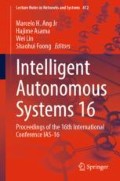Abstract
Pneumatic artificial muscle (PAM) has been widely applied to the rehabilitation field. On the other hand, PAM’s high nonlinearity makes it difficult to achieve precise force and motion control. Efforts have been made to use springs to deal with the slow responses. However, the role of pre-tensioned springs and mechanical structures making good use of them have not been sufficiently investigated. In this study, three joint structures combined pre-tensioned springs and PAM were modeled. Their sliding mode controllers were designed, then the control results were compared with canonical antagonistic PAM structure. Results showed that the structure with three pre-tensioned springs had achieve better step response and control accuracy than canonical antagonistic PAM structure.
Access this chapter
Tax calculation will be finalised at checkout
Purchases are for personal use only
References
Schulte, H.F.: The characteristics of the Mckibben artificial muscle. In: The Application of External Power in Prosthetics and Orthotics Appendix H, Publication 87, pp. 94–115. National Academy of Sciences, Washington DC (1961)
Shuguang, L.I., et al.: Fluid-driven origami-inspired artificial muscles. Proceed. Natl. Acad. Sci. 114(50), 13132–13137 (2017)
Caldwell, D.G., Medrano-Cerda, G.A., Goodwin, M.: Control of pneumatic muscle actuator. IEEE Control Syst. Mag. 15, 40–48 (1995)
Chou, C.-P., Hannaford, B.: Static and dynamic characteristics of McKibben pneumatic artificial muscles. In: Proceedings of the 1994 IEEE International Conference on Robotics and Automation, San Diego, CA, USA, vol. 1, pp. 281–286 (1994)
Andrikopoulos, G., Nikolakopoulos, G., Manesis, S.: A survey on applications of pneumatic artificial muscles. In: 2011 19th Mediterranean Conference on Control & Automation (MED), Corfu, pp. 1439–1446 (2011)
Tsagarakis, N.G., Caldwell, D.G.: Development and control of a ‘soft-actuated’ exoskeleton for use in physiotherapy and training. Auton. Robot. 15, 21–33 (2003)
Connolly, F., Walsh, C.J., Bertoldi, K.: Automatic design of fiber-reinforced soft actuators for trajectory matching. PNAS 114(1), 51–56 (2017)
Jun, W., et al.: A wearable rehabilitation robotic hand driven by PM-TS actuators. In: International Conference on Intelligent Robotics and Applications. Springer, Berlin, Heidelberg (2010). https://doi.org/10.1007/978-3-642-16587-0_41
Petit, F., Chalon, M., Friedl, W., Grebenstein, M., Albu-Schäffer, A., Hirzinger, G.: Bidirectional antagonistic variable stiffness actuation: analysis, design & Implementation. In: 2010 IEEE International Conference on Robotics and Automation, Anchorage, AK, pp. 4189–4196 (2010)
Xing, K., Huang, J., He, J., Wang, Y., Xu, Q., Wu, J.: Sliding mode tracking for actuators comprising pneumatic muscle and torsion spring. Trans. Inst. Meas. Control 34(2/3), 255–277 (2012)
Lee, I.-F., et al.: Squat and standing motion of a single robotic leg using pneumatic artificial muscles. J. Appl. Sci. Eng. 18(4), 363–370 (2015)
Kizilhan, H., Baser, O., Kilic, E., Ulusoy, N.: Comparison of controllable transmission ratio type variable stiffness actuator with antagonistic and pre-tension type actuators for the joints exoskeleton robots. In: 2015 12th International Conference on Informatics in Control, Automation and Robotics (ICINCO), Colmar, pp. 188–195 (2015)
Tondu, B.: Modelling of the McKibben artificial muscle: a review. J. Intell. Mater. Syst. Struct. 23(3), 225–253 (2012)
Chou, C.P., Hannaford, B.: Measurement and modeling of McKibben pneumatic artificial muscles. IEEE Trans. Robot. Autom. 12(1), 90–102 (1996)
Reynolds, D.B., Repperger, D.W., Phillips, C.A., Bandry, G.: Modeling the dynamic characteristics of pneumatic muscle. Ann. Biomed. Eng. 31(3), 310–317 (2003)
Karnjanaparichat, T., Pongvuthithum, R.: Adaptive tracking control of multi-link robots actuated by pneumatic muscles with additive disturbances. Robotica 35(11), 2139–2156 (2017)
Andrikopoulos, G., Nikolakopoulos, G., Manesis, S.: Advanced nonlinear PID-based antagonistic control for pneumatic muscle actuators. IEEE Trans. Ind. Electron. 61(12), 6926–6937 (2014)
Xu, Y.: Chattering free robust control for nonlinear systems. IEEE Trans. Control Syst. Technol. 16(6), 1352–1359 (2008)
Lilly, J.H., Quesada, P.M.: A two-input sliding-mode controller for a planar arm actuated by four pneumatic muscle groups. IEEE Trans. Neural Syst. Rehabil. Eng. 12(3), 349–359 (2004)
Cao, J., Xie, S.Q., Das, R.: MIMO sliding mode controller for gait exoskeleton driven by pneumatic muscles. In: The IEEE Control Systems Society Publishes High-Quality Papers on Technological Advances in The Design, Realization, and Operation of Control Systems, vol. 26, no. 1 (Jan 2018)
Chang, M.-K.: An adaptive self-organizing fuzzy sliding mode controller for a 2-DOFrehabilitation robot actuated by pneumatic muscle actuators. Control. Eng. Pract. 18(1), 13–22 (2010)
Author information
Authors and Affiliations
Corresponding author
Editor information
Editors and Affiliations
Rights and permissions
Copyright information
© 2022 The Author(s), under exclusive license to Springer Nature Switzerland AG
About this paper
Cite this paper
Zhou, Z., Wang, Y., Yu, W. (2022). A Simulation Study for Evaluating the Role of Pre-tensioned Springs in 3 Pneumatic Artificial Muscle Driven Joint Mechanisms with Sliding Mode Controllers. In: Ang Jr, M.H., Asama, H., Lin, W., Foong, S. (eds) Intelligent Autonomous Systems 16. IAS 2021. Lecture Notes in Networks and Systems, vol 412. Springer, Cham. https://doi.org/10.1007/978-3-030-95892-3_25
Download citation
DOI: https://doi.org/10.1007/978-3-030-95892-3_25
Published:
Publisher Name: Springer, Cham
Print ISBN: 978-3-030-95891-6
Online ISBN: 978-3-030-95892-3
eBook Packages: Intelligent Technologies and RoboticsIntelligent Technologies and Robotics (R0)

